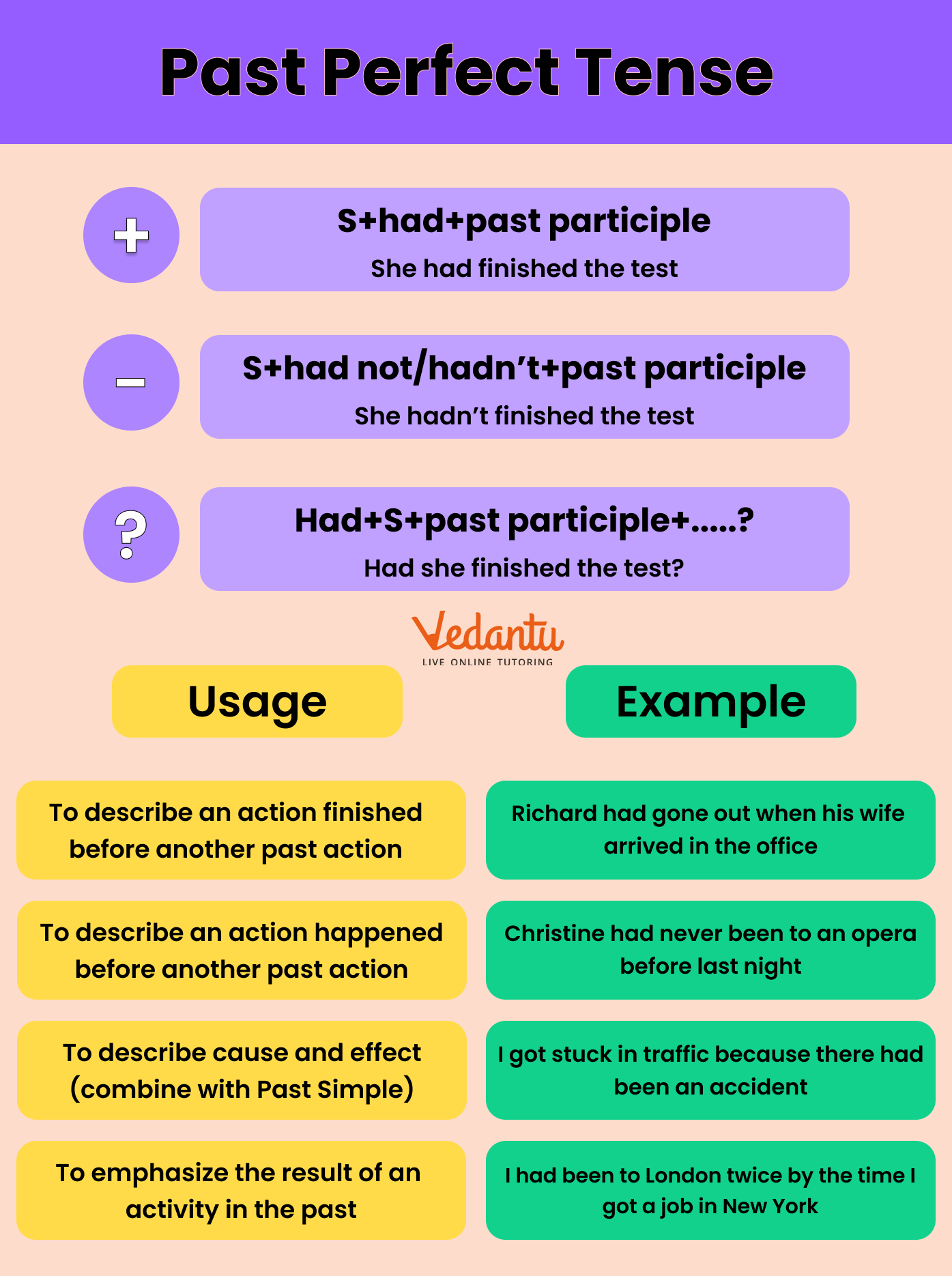




Key Uses of the Past Perfect Tense with Practical Examples
FAQs on Past Perfect Tense Explained: When and How to Use It
1. What is the Past Perfect Tense and when is it primarily used?
The Past Perfect Tense is used to describe an action that was completed before another action in the past. It clarifies the sequence of events, showing which one happened first. For example, in the sentence, "The train had left by the time we reached the station," the train leaving happened before we arrived.
2. What is the formula for forming sentences in the Past Perfect Tense?
The structure of the Past Perfect Tense is straightforward and uses the auxiliary verb 'had' with the past participle of the main verb. The formula varies slightly for different sentence types:
- Positive: Subject + had + Past Participle + Object. (e.g., She had finished the report.)
- Negative: Subject + had + not + Past Participle + Object. (e.g., She had not finished the report.)
- Interrogative (Question): Had + Subject + Past Participle + Object? (e.g., Had she finished the report?)
3. What is the key difference between the Past Perfect and the Simple Past Tense?
The main difference is their function in sequencing. The Simple Past Tense describes actions that happened at a specific point in the past (e.g., "He sold his car."). The Past Perfect Tense is used to show an action that happened before another past action (e.g., "He sold the car that he had bought five years ago."). Using Past Perfect here clarifies that buying the car happened long before selling it.
4. How does the Past Perfect Tense work with regular and irregular verbs?
The rule of using 'had' remains the same for both verb types. The only thing that changes is the past participle form of the main verb. For regular verbs, the past participle is usually the same as the simple past form (ending in -ed). For irregular verbs, the past participle has a unique form that must be memorized.
- Regular Verb Example: They had played chess for hours.
- Irregular Verb Example: She had written the letter before noon.
5. In what situations is the Past Perfect Tense used in reported speech?
In reported or indirect speech, the Past Perfect Tense is used when 'back-shifting' from the Simple Past or Present Perfect Tense. If the original statement was in the Present Perfect or Simple Past, it moves 'back' one step to Past Perfect to maintain the correct time sequence relative to the reporting verb. For example, the direct speech "I have seen that movie" becomes "She said that she had seen that movie" in reported speech.
6. How is the Past Perfect Tense a useful tool in storytelling and narrative writing?
In storytelling, the Past Perfect Tense is essential for providing background information or flashbacks without disrupting the main narrative's timeline. It allows the author to tell the reader about events that occurred before the main story's past setting began. For instance, "The detective entered the room. It was the same room where the victim had lived for ten years." This gives context without leaving the primary story timeline.
7. Why is the Past Perfect Tense important for talking about unreal or hypothetical past conditions?
The Past Perfect Tense is a crucial component of the Third Conditional, which is used to discuss unreal past situations and their hypothetical outcomes. It describes a condition in the past that did not happen. For example, in "If I had known you were coming, I would have baked a cake," the phrase "had known" establishes an unreal past condition—the speaker did not know, and therefore, the hypothetical result (baking a cake) did not happen.
8. What is a common mistake students make when using the Past Perfect Tense?
A common mistake is overusing the Past Perfect Tense when the Simple Past would be clearer and more natural. If events in a story are told in chronological order, using the Simple Past for each is sufficient. The Past Perfect should only be used when you need to jump back in time to clarify that a past action happened before another past action that has already been mentioned.























